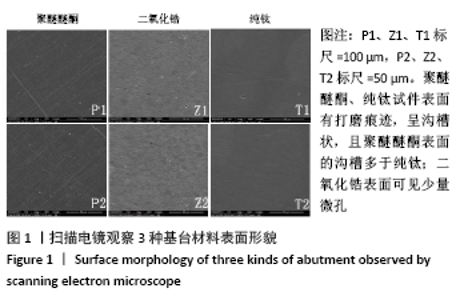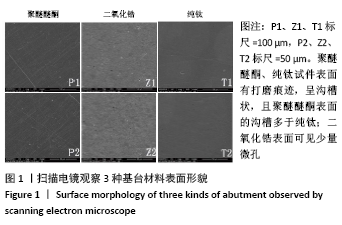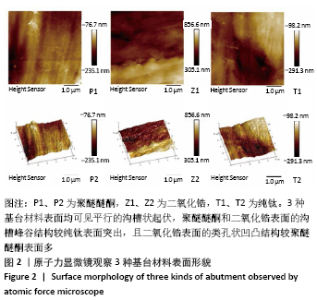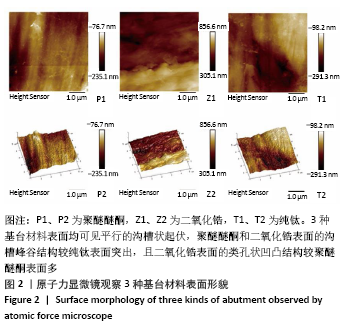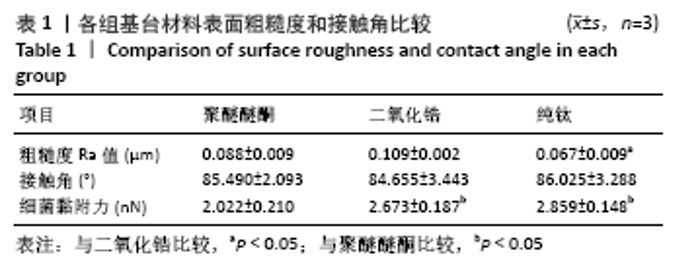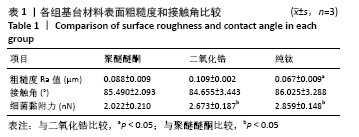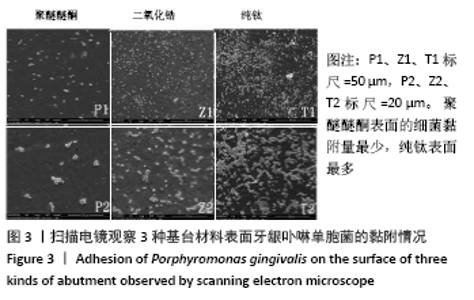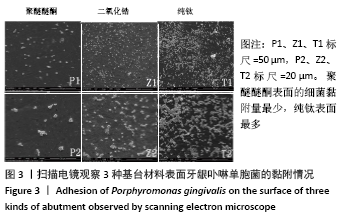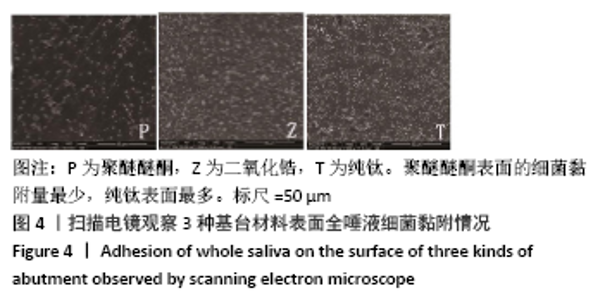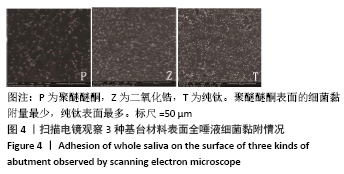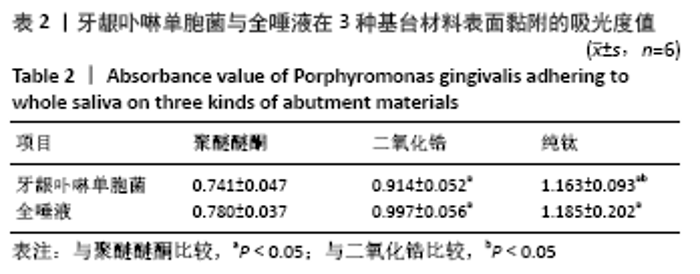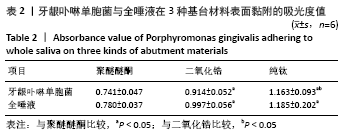Chinese Journal of Tissue Engineering Research ›› 2022, Vol. 26 ›› Issue (4): 540-545.doi: 10.12307/2022.089
Previous Articles Next Articles
Comparison of oral micro-adhesion on polyetheretherketone, zirconium dioxide, and pure titanium abutment
Qiu Peng1, 2, Fu Qilin3, Liu Min1, 2, Lan Yuyan1, 2, Wang Pin1, 2
- 1Oral & Maxillofacial Reconstruction and Regeneration Laboratory, Southwest Medical University, Luzhou 646000, Sichuan Province, China; 2Department of Prosthodontics, Affiliated Stomatology Hospital of Southwest Medical University, Luzhou 646000, Sichuan Province, China; 3Department of Stomatology, The Third Hospital of Mianyang, Mianyang 621000, Sichuan Province, China
-
Received:2020-10-12Revised:2020-10-14Accepted:2020-11-21Online:2022-02-08Published:2021-11-03 -
Contact:Wang Pin, Master, Attending physician, Oral & Maxillofacial Reconstruction and Regeneration Laboratory, Southwest Medical University, Luzhou 646000, Sichuan Province, China; Department of Prosthodontics, Affiliated Stomatology Hospital of Southwest Medical University, Luzhou 646000, Sichuan Province, China -
About author:Qiu Peng, Master candidate, Oral & Maxillofacial Reconstruction and Regeneration Laboratory, Southwest Medical University, Luzhou 646000, Sichuan Province, China; Department of Prosthodontics, Affiliated Stomatology Hospital of Southwest Medical University, Luzhou 646000, Sichuan Province, China -
Supported by:the Joint Project of Luzhou science and Technology Bureau Luzhou Medical College of Science and Technology Department of Sichuan Province, No. LY-51 (to LM); the Medical Research Project of Sichuan Province, No. S19023 (to LM); Luzhou Science and Technology Bureau, No. [2015-S-50, (1/3)] (to LYY); Innovation and Entrepreneurship Project of Sichuan Medical University of Department of Education of Sichuan Province, No. 2015130 (to LYY); School-Level Education and Teaching Reform Project of Sichuan Medical University, No. JG2015055 (to LYY)
CLC Number:
Cite this article
Qiu Peng, Fu Qilin, Liu Min, Lan Yuyan, Wang Pin. Comparison of oral micro-adhesion on polyetheretherketone, zirconium dioxide, and pure titanium abutment[J]. Chinese Journal of Tissue Engineering Research, 2022, 26(4): 540-545.
share this article
Add to citation manager EndNote|Reference Manager|ProCite|BibTeX|RefWorks
| [1] SALA L, BASCONES-MARTÍNEZ A, CARRILLO-DE-ALBORNOZ A. Impact of abutment material on peri-implant soft tissue color. An in vitro study. Clin Oral Investig. 2017;21(7):2221-2233. [2] PITTA J, ZARAUZ C, PJETURSSON B, et al. A Systematic Review and Meta-Analysis of the Influence of Abutment Material on Peri-implant Soft Tissue Color Measured Using Spectrophotometry. Int J Prosthodont. 2020;33(1):39-47. [3] THOMA D, IOANNIDIS A, CATHOMEN E, et al. Discoloration of the Peri-implant Mucosa Caused by Zirconia and Titanium Implants. Int J Periodontics Restorative Dent. 2016;36(1):39-45. [4] ROSKIES M, JORDAN J, FANG D, et al. Improving PEEK bioactivity for craniofacial reconstruction using a 3D printed scaffold embedded with mesenchymal stem cells. J Biomater Appl. 2016;31(1):132-139. [5] 陈曦,于海洋.聚醚醚酮在口腔种植与修复领域的研究进展[J].国际口腔医学杂志,2018,45(6):657-665. [6] HAN C, LEE E, KIM H, et al. The electron beam deposition of titanium on polyetheretherketone (PEEK) and the resulting enhanced biological properties. Biomaterials. 2010;31(13):3465-3470. [7] TANNOUS F, STEINER M, SHAHIN R, et al. Retentive forces and fatigue resistance of thermoplastic resin clasps. Dent Mater. 2012;28(3):273-278. [8] 秦胜男,贾慧,李英.聚醚醚酮在口腔临床中的应用现状[J].国际口腔医学杂志,2018,45(6):652-656. [9] 宋应亮,张思佳.对种植体周围炎的认识与预防[J].华西口腔医学杂志, 2020,38(5):479-483. [10] 郑桂婷,徐燕,吴明月.种植体周围疾病治疗的专家共识及治疗方法的进展[J].国际口腔医学杂志,2020,47(6):725-731. [11] TONETTI M, CHAPPLE I, JEPSEN S, et al. Primary and secondary prevention of periodontal and peri-implant diseases: Introduction to, and objectives of the 11th European Workshop on Periodontology consensus conference. J Clin Periodontol. 2015;42 Suppl 16:S1-4. [12] WISDOM C, CHEN C, YUCA E, et al. Repeatedly Applied Peptide Film Kills Bacteria on Dental Implants. JOM (1989). 2019;71(4):1271-1280. [13] PRADO A, PEREIRA J, HENRIQUES B, et al. Biofilm Affecting the Mechanical Integrity of Implant-Abutment Joints. Int J Prosthodont. 2016;29(4):381-383. [14] GIBBS S, ROFFEL S, MEYER M, et al. Biology of soft tissue repair: gingival epithelium in wound healing and attachment to the tooth and abutment surface. Eur Cell Mater. 2019;38:63-78. [15] ROMANOS G, DELGADO-RUIZ R, SCULEAN A. Concepts for prevention of complications in implant therapy. Periodontol 2000. 2019;81(1):7-17. [16] CHACKARTCHI T, ROMANOS G, SCULEAN A. Soft tissue-related complications and management around dental implants. Periodontol 2000. 2019;81(1):124-138. [17] KOUTOUZIS T. Implant-abutment connection as contributing factor to peri-implant diseases. Periodontol 2000. 2019;81(1):152-166. [18] DAUBERT D, WEINSTEIN B. Biofilm as a risk factor in implant treatment. Periodontol 2000. 2019;81(1):29-40. [19] RIGOLIN M, DE AVILA E, BASSO F, et al. Effect of different implant abutment surfaces on OBA-09 epithelial cell adhesion. Microsc Res Tech. 2017;80(12):1304-1309. [20] GHEISARIFAR M, THOMPSON G, DRAGO C, et al. In vitro study of surface alterations to polyetheretherketone and titanium and their effect upon human gingival fibroblasts. J Prosthet Dent. 2021;125(1):155-164. [21] NASCIMENTO CD, PITA MS, FERNANDES F, et al. Bacterial adhesion on the titanium and zirconia abutment surfaces. Clin Oral Implants Res. 2014;25(3):337-343. [22] CHARALAMPAKIS G, LEONHARDT Å, RABE P, et al. Clinical and microbiological characteristics of peri‐implantitis cases: a retrospective multicentre study. Clin Oral Implants Res. 2012;23(9):1045-1054. [23] BARKARMO S, LONGHORN D, LEER K, et al. Biofilm formation on polyetheretherketone and titanium surfaces. Clin Exp Dent Res. 2019;5(4):427-437. [24] O’TOOLE G, KAPLAN HB, KOLTER R. Biofilm formation as microbial development. Annu Rev Microbiol. 2000;54(1):49-79. [25] 高宁,肖晓蓉,柴枫,等.两种种植材料对龈下优势菌生长及生长环境的影响[J].华西医科大学学报,2002,33(1):62-64,107. [26] ESFAHANIZADEH N, MIRMALEK S, BAHADOR A, et al. Formation of biofilm on various implant abutment materials. Gen Dent. 2018;66(5):39-44. [27] DE AVILA E, AVILA-CAMPOS M, VERGANI C, et al. Structural and quantitative analysis of a mature anaerobic biofilm on different implant abutment surfaces. J Prosthet Dent. 2016;115(4):428-436. [28] HAHNEL S, WIESER A, LANG R, et al. Biofilm formation on the surface of modern implant abutment materials. Clin Oral Implants Res. 2015;26(11):1297-1301. [29] D’ERCOLE S, CELLINI L, PILATO S, et al. Material characterization and Streptococcus oralis adhesion on Polyetheretherketone (PEEK) and titanium surfaces used in implantology. J Mater Sci Mater Med. 2020;31(10):84. [30] GORTH DJ, PUCKETT S, ERCAN B, et al. Decreased bacteria activity on Si(3)N(4) surfaces compared with PEEK or titanium. Int J Nanomedicine. 2012;7:4829-4840. [31] BRUM R, LABES L, VOLPATO C, et al. Strategies to Reduce Biofilm Formation in PEEK Materials Applied to Implant Dentistry-A Comprehensive Review. Antibiotics (Basel). 2020;9(9):609. [32] LORENZETTI M, DOGSA I, STOSICKI T, et al. The influence of surface modification on bacterial adhesion to titanium-based substrates. ACS Appl Mater Interfaces. 2015;7(3):1644-1651. [33] Quirynen M, van der Mei H, Bollen C. An in vivo study of the influence of the surface roughness of implants on the microbiology of supra- and subgingivalplaque. J Dent Res. 1993;72(9):1304-1309. [34] 陈玉婷,李蜀光.种植体表面材料抑菌性的研究进展[J].口腔颌面外科杂志, 2007,17(4):366-368. [35] TEGOULIA VA, COOPER SL. Staphylococcus aureus adhesion to self-assembled monolayers: effect of surface chemistry and fibrinogen presence. Colloids Surf B Biointerfaces. 2002;24(3):217-228. [36] ZHANG X, WANG L, LEVÄNEN E. Superhydrophobic surfaces for the reduction of bacterial adhesion. RSC Adv. 2013;3(30):12003-12020. [37] BOCK RM, JONES EN, RAY DA, et al. Bacteriostatic behavior of surface modulated silicon nitride in comparison to polyetheretherketone and titanium. J Biomed Mater Res A. 2017;105(5):1521-1534. [38] LI B, LOGAN BE. Bacterial adhesion to glass and metal-oxide surfaces. Colloids Surf B Biointerfaces. 2004;36(2):81-90. [39] MEI L, VAN DER MEI HC, REN Y, et al. Poisson analysis of streptococcal bond strengthening on stainless steel with and without a salivary conditioning film. Langmuir. 2009;25(11):6227-6231. [40] WEI W, WANG S, HO F. Electrokinetic properties of colloidal zirconia powders in aqueous suspension. J Am Ceram Soc. 1999;82(12):3385-3392. [41] WEBSTER TJ, PATEL AA, RAHAMAN MN, et al. Anti-infective and osteointegration properties of silicon nitride, poly(ether ether ketone), and titanium implants. Acta Biomater. 2012;8(12):4447-4454. [42] VAZ J, PEZZOLI D, CHEVALLIER P, et al. Antibacterial Coatings Based on Chitosan for Pharmaceutical and Biomedical Applications. Curr Pharm Des. 2018;24(8):866-885. [43] LI B, XIA X, GUO M, et al. Biological and antibacterial properties of the micro-nanostructured hydroxyapatite/chitosan coating on titanium. Sci Rep. 2019;9(1): 14052. [44] IKEDA T, HIRAYAMA H, YAMAGUCHI H, et al. Polycationic biocides with pendant active groups: molecular weight dependence of antibacterial activity. Antimicrob Agents Chemother. 1986;30(1):132-136. [45] MOONGRAKSATHUM B, CHIEN M, CHEN Y. Antiviral and Antibacterial Effects of Silver-Doped TiO₂ Prepared by the Peroxo Sol-Gel Method. J Nanosci Nanotechnol. 2019;19(11):7356-7362. [46] SEDELNIKOVA M, KOMAROVA E, SHARKEEV Y, et al. Modification of titanium surface via Ag-, Sr- and Si-containing micro-arc calcium phosphate coating. Bioact Mater. 2019;4(undefined):224-235. [47] SIVARAJ D, VIJAYALAKSHMI K. Enhanced antibacterial and corrosion resistance properties of Ag substituted hydroxyapatite/functionalized multiwall carbon nanotube nanocomposite coating on 316L stainless steel for biomedical application. Ultrason Sonochem. 2019;59:104730. |
| [1] | Wang Can, Gu Weiping, Jiang Yubin, Zhu Lin, Chen Gang. Finite element analysis of the influence of different implant designs on the stress of mandibular edentulous jaw [J]. Chinese Journal of Tissue Engineering Research, 2022, 26(4): 573-578. |
| [2] | Han Mingzhan, Maihemuti·Yakufu, Chen Hongtao, Liu Jianjiang, Abudusufu·Kuwan, Aierken·Amudong. Patellar suture anchors and semi-tunneling polyetheretherketone suture anchors for double-bundle reconstruction of medial patellofemoral ligament [J]. Chinese Journal of Tissue Engineering Research, 2022, 26(12): 1854-1860. |
| [3] | Liang Pengchen, Shi Junfeng, Sun Miaomiao, Liang Dongyu, Sha Shuang, Yi Qingqing, Chang Qing. Polydopamine assisted salidroside to improve bone formation on micro-arc oxidation of pure titanium [J]. Chinese Journal of Tissue Engineering Research, 2022, 26(10): 1522-1529. |
| [4] | Zhang Feng. Long-term effects and adverse events of polyetheretherketone versus titanium mesh materials in repairing skull defects: a prospective, single-center, non-randomized controlled, 2-year follow-up clinical trial protocol [J]. Chinese Journal of Tissue Engineering Research, 2021, 25(34): 5501-5505. |
| [5] | Li Rong, Zuo Enjun. Gingival retraction: application profiles and hot spotlights [J]. Chinese Journal of Tissue Engineering Research, 2021, 25(2): 322-328. |
| [6] | Liu Chundong, Shen Xiaoqing, Zhang Yanli, Zhang Xiaogen, Wu Buling. Effects of strontium-modified titanium surfaces on adhesion, migration and proliferation of bone marrow mesenchymal stem cells and expression of bone formation-related genes [J]. Chinese Journal of Tissue Engineering Research, 2020, 24(7): 1009-1015. |
| [7] | Wei Yangyang, Chen Jiacheng, Sun Jun, Wang Qiuan, Yuan Feng. Comparison of lumbar-pelvic sagittal parameters after single-level and double-level posterior lumbar interbody fusion [J]. Chinese Journal of Tissue Engineering Research, 2020, 24(33): 5300-5306. |
| [8] | Cheng Lei, Jin Jian, Hu Jingguo, Lu Yusong. Inflammatory reaction and lactic acid concentration after implantation of polylactic acid rib nail versus pure titanium embracing fixator in animals#br# [J]. Chinese Journal of Tissue Engineering Research, 2020, 24(16): 2567-2571. |
| [9] | Wang Zuopei, Xie Xinjie, Sheng Bo, Ding Yi, Lu Yi, Cheng Mengqi. Pure titanium rib plate fixation treats rib facture: pain analysis compared with conservative treatment [J]. Chinese Journal of Tissue Engineering Research, 2019, 23(22): 3512-3517. |
| [10] | Chai Le, Quan Renfu, Lü Jianlan, Huang Xiaolong, Zhang Can, Ren Weifan, Qian Jiansheng. Physicochemical properties and cellularization of hydroxyapatite/zirconium dioxide foam ceramics [J]. Chinese Journal of Tissue Engineering Research, 2019, 23(18): 2871-2879. |
| [11] | Xu Qunhao, Lu Yupu, Bai Yuhong. Bacterial adhesion of SureFil SDR as a preventive resin filling [J]. Chinese Journal of Tissue Engineering Research, 2019, 23(10): 1496-1500. |
| [12] | Sang Zhuo, Fu Yu, Chen Dong, Gu Yu-di, Chen Xiang-tao. Cobalt-chromium alloy with zirconium nitride coating influences adhesion properties of bacteria [J]. Chinese Journal of Tissue Engineering Research, 2015, 19(25): 4033-4037. |
| [13] | Chen Yao-zhong, Liu Gen-di, Song Ping, Gao Feng. Evaluating cytotoxicity of four different dental metal materials toward L-929 cells using three assay systems [J]. Chinese Journal of Tissue Engineering Research, 2013, 17(8): 1390-1397. |
| [14] | Ma Ying, Meng Xiang-cai, Wang Jing, Li De-chao. Endosseous implantation of calcium phosphate coated titanium implant prepared via micro-arc oxidation/electrochemical deposition [J]. Chinese Journal of Tissue Engineering Research, 2013, 17(25): 4570-4576. |
| [15] | Yuan Qing-ling, Yan Jun, Zheng Qi, Zhang Shao-xiang, Zhang Xiao-nong. Molecular biocompatibility of a magnesium-zinc alloy implanted in animals [J]. Chinese Journal of Tissue Engineering Research, 2013, 17(16): 2921-2926. |
| Viewed | ||||||
|
Full text |
|
|||||
|
Abstract |
|
|||||
